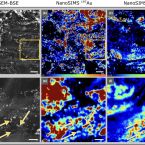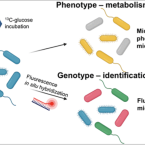Publications
Publications in peer reviewed journals
Gold-FISH enables targeted NanoSIMS analysis of plant-associated bacteria
2023 - New Phytologist, in press
Abstract:
Bacteria colonize plant roots and engage in reciprocal interactions with their hosts. However, the contribution of individual taxa or groups of bacteria to plant nutrition and fitness is not well characterized due to a lack of in situ evidence of bacterial activity. To address this knowledge gap, we developed an analytical approach that combines the identification and localization of individual bacteria on root surfaces via gold-based in situ hybridization with correlative NanoSIMS imaging of incorporated stable isotopes, indicative of metabolic activity. We incubated Kosakonia strain DS-1-associated, gnotobiotically grown rice plants with 15 N-N2 gas to detect in situ N2 fixation activity. Bacterial cells along the rhizoplane showed heterogeneous patterns of 15 N enrichment, ranging from the natural isotope abundance levels up to 12.07 at% 15 N (average and median of 3.36 and 2.85 at% 15 N, respectively, n = 697 cells). The presented correlative optical and chemical imaging analysis is applicable to a broad range of studies investigating plant-microbe interactions. For example, it enables verification of the in situ metabolic activity of host-associated commercialized strains or plant growth-promoting bacteria, thereby disentangling their role in plant nutrition. Such data facilitate the design of plant-microbe combinations for improvement of crop management.
Mid-Infrared Photothermal-Fluorescence In Situ Hybridization for Functional Analysis and Genetic Identification of Single Cells.
2023 - Anal Chem, 4: 2398-2405
Abstract:
Simultaneous identification and metabolic analysis of microbes with single-cell resolution and high throughput are necessary to answer the question of "who eats what, when, and where" in complex microbial communities. Here, we present a mid-infrared photothermal-fluorescence in situ hybridization (MIP-FISH) platform that enables direct bridging of genotype and phenotype. Through multiple improvements of MIP imaging, the sensitive detection of isotopically labeled compounds incorporated into proteins of individual bacterial cells became possible, while simultaneous detection of FISH labeling with rRNA-targeted probes enabled the identification of the analyzed cells. In proof-of-concept experiments, we showed that the clear spectral red shift in the protein amide I region due to incorporation of C atoms originating from C-labeled glucose can be exploited by MIP-FISH to discriminate and identify C-labeled bacterial cells within a complex human gut microbiome sample. The presented methods open new opportunities for single-cell structure-function analyses for microbiology.



